
The Telescopes and Astronomical Instruments of Captain James Cook
Two hundred and fifty years ago, an astronomical event took place that would profoundly effect the history of exploration and lead to the discovery and charting of New Zealand, the East Coast of Australia, and the Hawaiian islands. This event was the Transit of Venus. In 1716, Edmund Halley proposed that the distance from the Sun to the Earth could be calculated by timing the transit of Venus across the face of the Sun. Transits are quite rare, and the next wouldn't occur until 1874.
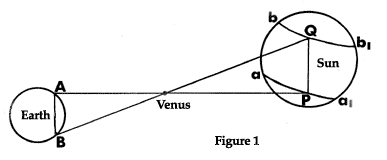
Halley's proposal is explained in Figure 1. An observer at point A in the northern hemisphere would see Venus crossing the sun along the line a to a1. An observer at point B in the southern hemisphere would see Venus crossing the Sun along the line b to b1. Measuring the distance PG will give a measure of the sun's distance from the earth. A good ship and a capable master were needed to make the voyage successful.
Lieutenant James Cook was chosen to command the bark Endeavour. Cook had already proved himself an able geographer and ship's master. He had performed a crucial charting of the St. Lawrence River, which made possible the great amphibious assault upon Quebec City in 1759. In 1763 he was given command of the schooner Grenville to survey the eastern coasts of Canada over a four year period. These charts were so accurate that they were used up until the early part of the 20th century.
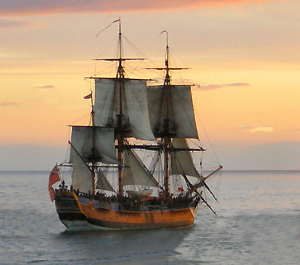 For the Transit of Venus voyage, James Cook was recommended by the Royal Geographic Society, eager to promote science and discovery.
But the Admiralty and George III had more than just scientific motives when they approved the voyage.
Captain Cook was given secret orders to discover and chart all unknown lands in the South Seas and annex
them for Britain. The continents of Australia, Antarctica, and the North-West Passage were as yet unknown to European map makers.
For the Transit of Venus voyage, James Cook was recommended by the Royal Geographic Society, eager to promote science and discovery.
But the Admiralty and George III had more than just scientific motives when they approved the voyage.
Captain Cook was given secret orders to discover and chart all unknown lands in the South Seas and annex
them for Britain. The continents of Australia, Antarctica, and the North-West Passage were as yet unknown to European map makers.
Observations of the 1761 transits had been disappointing. For Cook's voyage, instruments were chosen to insure more accurate measurements of the transit than had ever been attained. To observe the transit itself, a telescope fitted with a micrometer and a good pendulum clock were needed. Three British Transit of Venus expeditions sponsored by the Royal Society were supplied with telescopes by James Short, John Bird, or Peter Dollond. For Cook's first voyage, four clocks were provided, three by John Shelton and one by George Graham.
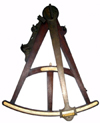
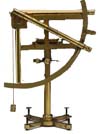 Since it was necessary to determine an exact longitude and latitude of the observer, a quadrant
would also be required. A quadrant measures the altitudes of celestial objects to obtain the latitude
and to check the clocks. Cook was supplied with one or more astronomical quadrants of one foot radius
by John Bird, like the one at right. These would be used on shore. While afloat, he would use the finest available Hadley reflecting sextant, shown on the left. These devices allow the explorer to determine the elevation of celestial objects with respect to the horizon. Cook could calculate his latitude as long as the position of the object on the sky and the time of the observation were known. (Also see: Longitude, by Dava Sobel.)
Since it was necessary to determine an exact longitude and latitude of the observer, a quadrant
would also be required. A quadrant measures the altitudes of celestial objects to obtain the latitude
and to check the clocks. Cook was supplied with one or more astronomical quadrants of one foot radius
by John Bird, like the one at right. These would be used on shore. While afloat, he would use the finest available Hadley reflecting sextant, shown on the left. These devices allow the explorer to determine the elevation of celestial objects with respect to the horizon. Cook could calculate his latitude as long as the position of the object on the sky and the time of the observation were known. (Also see: Longitude, by Dava Sobel.)
Finally, he carried portable observatories, tents made of wood and canvas, in which the clocks and instruments would be set up to protect them from the weather and the natives. The tents had openings in the roof which could be rotated to follow the stars and planets with the telescopes.
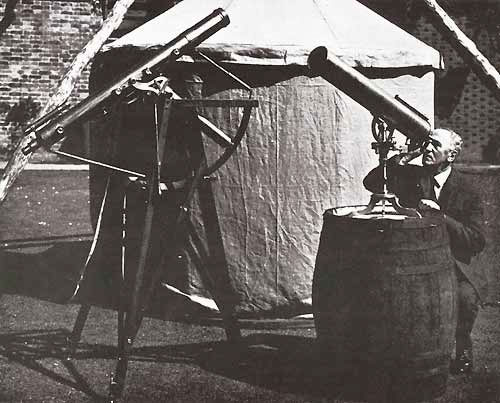
On the right is a photo of two telescopes and an observatory tent similar to those used by Cook in his expeditions. The refractor on the tall wooden tripod is a triple achromat by Dollond, 3 and 3/4 inches aperture, 46 inch focal length, made in 1767. The man is looking through a reflector made by James Short, 4 and 3/4 inches in aperture, 24 inch focal length, built in 1763. Both belong to St. John's College in Cambridge.
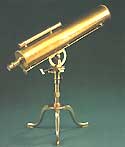
Click on the image at left to see a reflecting telescope made by James Short in London in the 18th century. This scope has a 4-inch objective mirror and a 24-inch focal length.
It was the first of three great voyages of discovery that Cook led in the South Pacific. He rounded Cape Horn in the Endeavour and reached Tahiti on 3 June 1769. After recovering a necessary scientific instrument stolen by the natives, the transit of Venus was successfully observed. The Endeavour then spent six months charting New Zealand. James Cook next explored and claimed possession of eastern Australia. The Endeavour returned to England, on 12 June 1771, via New Guinea, Java and the Cape of Good Hope.
The object of Captain Cook's second Pacific Ocean voyage was to confirm the existence of a theorized Great Southern Continent. His ship the Resolution, accompanied by the Adventure, departed Plymouth on 13 July 1772 and sailed around the Cape of Good Hope. Beset by ice, he was unable to reach Antarctica. Although its existence was suspected, James Cook demonstrated, by traversing large areas of the south Pacific, that it would have to be a frigid wasteland, and not an economically productive addition to the British empire. James Cook charted many of the South Pacific islands with the incredible accuracy of 3 miles. This accuracy was made possible by a new and highly accurate clock. The two ships returned to England, via Cape Horn, on 29 July 1775. Since public interest was high, many paintings by artists were widely displayed and published as engravings. James Cook was also awarded the Copley Gold Medal and elected as a fellow of the Royal Society.
The third great voyage is especially significant to the history of the west coast of North America. Captain Cook and his men were primarily searching for the Northwest Passage from the Pacific Ocean to the Atlantic Ocean. They departed Plymouth on 12 July 1776 in the Resolution and the Discovery.
The ships sailed around the Cape of Good Hope to reach the west coast of America in February of 1778. They continued north along the coast in haste to the Bering Sea and Bering Strait in an attempt to pass through the Arctic Ocean during the summer season. Foiled by ice, James Cook returned to Hawaii to prepare for another attempt at the Northwest Passage the next season. Soon after they had departed, a storm damaged the foremast of the Resolution and forced a return to Kealakekua Bay for repairs. Unfortunately, they had previously overstayed their welcome and relations became tense. The theft of a ship's cutter led Captain Cook to put ashore to demand the return of the boat. A fight broke out and James Cook was killed on 14 Feb 1779 by angry natives.

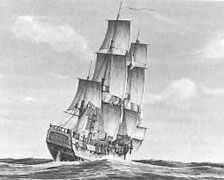 The Space Shuttle Endeavor is the newest addition to NASA's shuttle fleet. It is the fifth spacecraft in the shuttle program of exploration and discovery. A drawing of Captain Cook's vessel was commissioned by the National Geographic Society.
The Space Shuttle Endeavor is the newest addition to NASA's shuttle fleet. It is the fifth spacecraft in the shuttle program of exploration and discovery. A drawing of Captain Cook's vessel was commissioned by the National Geographic Society.